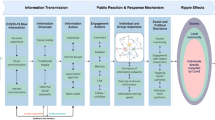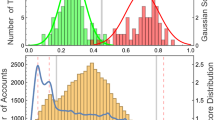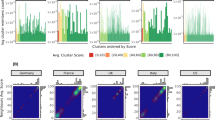Abstract
Social media platforms are information battlegrounds where actors or communities compete to influence ideas and beliefs. These platforms can benefit government and health organizations by quickly disseminating pertinent information about the COVID-19 vaccine to a large population. However, at the same time, the social-cyberspace domain has made it easy for counter-messages to gain mainstream support and widespread propagation. What were once isolated fringe groups can now distribute—on a massive scale—false healthcare narratives in the form of disinformation and conspiracy theories. Twitter is a popular online medium where COVID-19 pro- and anti-vaccine communities strive to convince large audiences of their particular stances. This chapter explores how these competing groups use different types of online manipulation techniques to spread information and influence their followers on Twitter. Using a corpus of COVID-19 tweets, we identify the key players and communities spreading the pro-vaccine- and anti-vaccine-related messages and their beliefs. We then analyze the labeled messages to determine how messages influence targets and impact the overall network using a novel influence assessment approach referred to as the BEND framework.
Access this chapter
Tax calculation will be finalised at checkout
Purchases are for personal use only
Similar content being viewed by others
References
Alaphilippe, A. (2020). Adding a “D” to the ABC disinformation framework. The Brookings Institute. https://www.brookings.edu/techstream/adding-a-d-to-the-abc-disinformation-framework/
Altman, N., Carley, K. M., & Reminga, J. (2020). ORA user’s guide 2020. Carnegie Mellon University, School of Computer Science, Institute for Software Research. http://www.casos.cs.cmu.edu/publications/papers/CMU-ISR-20-110.pdf
Becker, B. F. H., Larson, H. J., Bonhoeffer, J., van Mulligen, E. M., Kors, J. A., & Sturkenboom, M. C. J. M. (2016). Evaluation of a multinational, multilingual vaccine debate on twitter. Vaccine, 34(50), 6166–6171. https://doi.org/10.1016/j.vaccine.2016.11.007
Beskow, D. M., & Carley, K. M. (2018). Bot-hunter: A tiered approach to detecting & characterizing ‘automated activity on twitter. SBP-brims: International Conference on Social Computing, Behavioral-Cultural Modeling and Prediction and Behavior Representation in Modeling and Simulation, 3, 3.
Beskow, D. M., & Carley, K. M. (2019). Social cybersecurity: An emerging national security requirement. Military Review, 99(2), 117–127.
Blane, J. T., Bellutta, D., & Carley, K. M. (2022). Social-cyber maneuvers during the COVID-19 vaccine initial rollout: Content analysis of tweets. Journal of Medical Internet Research, 24(3), e34040.
Blazek, S. (2021). SCOTCH: A framework for rapidly assessing influence operations. Atlantic Council. https://www.atlanticcouncil.org/blogs/geotech-cues/scotch-a-framework-for-rapidly-assessing-influence-operations/
Carley, K. M. (2020). Social cybersecurity: An emerging science. Computational and Mathematical Organization Theory, 26, 365–381. https://doi.org/10.1007/s10588-020-09322-9
Carley, L. R., Reminga, J., & Carley, K. M. (2018). Ora & netmapper. Proceedings of the International Conference on Social Computing, Behavioral-Cultural Modeling and Prediction and Behavior Representation in Modeling and Simulation. Springer, 3(3.3), 7.
Cruickshank, I., Ginossar, T., Sulskis, J., Zheleva, E., & Berger-Wolf, T. (2021). Content and dynamics of websites shared over vaccine-related tweets in COVID-19 conversations: Computational analysis. Journal of Medical Internet Research, 23(12), e29127. https://doi.org/10.2196/29127
Deiner, M. S., Fathy, C., Kim, J., Niemeyer, K., Ramirez, D., Ackley, S. F., Liu, F., Lietman, T. M., & Porco, T. C. (2019). Facebook and twitter vaccine sentiment in response to measles outbreaks. Health Informatics Journal, 25(3), 1116–1132. https://doi.org/10.1177/1460458217740723
Ghio, D., Lawes-Wickwar, S., Tang, M. Y., Epton, T., Howlett, N., Jenkinson, E., Stanescu, S., Westbrook, J., Kassianos, A. P., Watson, D., Sutherland, L., & Keyworth, C. (2021). What influences people’s responses to public health messages for managing risks and preventing infectious diseases? A rapid systematic review of the evidence and recommendations. BMJ Open, 11(11), e048750.
Ginossar, T., Cruickshank, I., Sulskis, J., Zheleva, E., & Berger-Wolf, T. (2022). Cross-platform spread: Vaccine-related content, sources, and conspiracy theories in YouTube videos shared in early twitter COVID-19 conversations. Human Vaccines & Immunotherapeutics, 18(1), 1–13.
Gunaratne, K., Coomes, E. A., & Haghbayan, H. (2019). Temporal trends in anti-vaccine discourse on twitter. Vaccine, 37(35), 4867–4871. https://doi.org/10.1016/j.vaccine.2019.06.086
Heise, D. R. (2007). Expressive order: Confirming sentiments in social actions. Springer.
Hussain, A., Ali, S., Ahmed, M., & Hussain, S. (2018). The anti-vaccination movement: A regression in modern medicine. Cureus, 10(7), e2919.
Johnson, N. F., Velásquez, N., Restrepo, N. J., Leahy, R., Gabriel, N., El Oud, S., Zheng, M., Manrique, P., Wuchty, S., & Lupu, Y. (2020). The online competition between pro-and anti-vaccination views. Nature, 582(7811), 230–233.
Kumar, S. (2020). Social media analytics for stance mining a multi-modal approach with weak supervision. PhD dissertation. Carnegie Mellon University.
Ng, L. H. X., & Carley, K. M. (2021a). “The coronavirus is a bioweapon”: Classifying coronavirus stories on fact-checking sites. Computational and Mathematical Organization Theory, 27(2), 179–194.
Ng L. H. X., & Carley, K. M. (2021b). Flipping stance: Social influence on bots’ and non bots’ COVID vaccine stance. Proceedings of the Second International MIS2 Workshop: Misinformation and Misbehavior Mining on the Web at KDD 2021.
Ng, L. H. X., & Carley, K. M. (2021c). Bot-based emotion behavior differences in images during Kashmir black day event. In R. Thomson, M. N. Hussain, C. Dancy, & A. Pyke (Eds.), Social, cultural, and behavioral modeling (pp. 184–194). Springer International Publishing. https://doi.org/10.1007/978-3-030-80387-2_18
Ng, L. H. X., Robertson, D. C., & Carley, K. M. (2022). Stabilizing a supervised bot detection algorithm: How much data is needed for consistent predictions? Online Social Networks and Media, 28, 100198.
Orr, D., Baram-Tsabari, A., & Landsman, K. (2016). Social media as a platform for health-related public debates and discussions: The polio vaccine on Facebook. Israel Journal of Health Policy Research, 5(1), 34. https://doi.org/10.1186/s13584-016-0093-4
Poland, G. A., & Jacobson, R. M. (2001). Understanding those who do not understand: A brief review of the anti-vaccine movement. Vaccine, 19(17–19), 2440–2445. https://doi.org/10.1016/S0264-410X(00)00469-2
Scannell, D., Desens, L., Guadagno, M., Tra, Y., Acker, E., Sheridan, K., Rosner, M., Mathieu, J., & Fulk, M. (2021). COVID-19 vaccine discourse on twitter: A content analysis of persuasion techniques, sentiment and mis/disinformation. Journal of Health Communication, 26(7), 443–459.
Twitter. (2021). Updating our approach to misleading information. https://blog.twitter.com/en_us/topics/product/2020/updating-our-approach-to-misleading-information
Uyheng, J., Ng, L. H. X., & Carley, K. M. (2021). Active, aggressive, but to little avail: Characterizing bot activity during the 2020 Singaporean elections. Computational and Mathematical Organization Theory, 27(3), 324–342.
Acknowledgements
The research for this chapter was supported in part by the Office of Naval Research (ONR) under grants N00014182106 and N000142112229, the Knight Foundation, the United States Army, and the Center for Informed Democracy and Social-cybersecurity (IDeaS). The views and conclusions are those of the authors and should not be interpreted as representing the official policies, either expressed or implied, of the Knight Foundation, the ONR, the United States Army, or the US Government.
Author information
Authors and Affiliations
Corresponding author
Editor information
Editors and Affiliations
Rights and permissions
Copyright information
© 2023 The Author(s), under exclusive license to Springer Nature Switzerland AG
About this chapter
Cite this chapter
Blane, J.T., Ng, L.H.X., Carley, K.M. (2023). Analyzing Social-Cyber Maneuvers for Spreading COVID-19 Pro- and Anti- Vaccine Information. In: Ginossar, T., Shah, S.F.A., Weiss, D. (eds) Vaccine Communication Online. Palgrave Macmillan, Cham. https://doi.org/10.1007/978-3-031-24490-2_4
Download citation
DOI: https://doi.org/10.1007/978-3-031-24490-2_4
Published:
Publisher Name: Palgrave Macmillan, Cham
Print ISBN: 978-3-031-24489-6
Online ISBN: 978-3-031-24490-2
eBook Packages: Literature, Cultural and Media StudiesLiterature, Cultural and Media Studies (R0)




